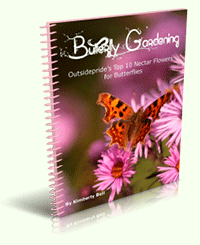Table of Contents
IntroductionCosmos
Echinacea
Agastache
Pentas
Salvia
Achilliea
Rudbeckia
Eupatorium
Aster
Monarda
Bonus Flower, Asclepias
Introduction
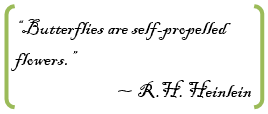 Not many people would consider themselves to be fans of insects. In fact, many of us are absolutely scared of them. There is, however, one beautiful insect that does not bring out the creepy-crawly feeling … the butterfly. Butterflies are colorful and graceful. We delight in their presence and look for ways to encourage their fluttering through our gardens. In recent years, more and more gardeners are gaining the skills to grow a garden that is butterfly friendly. We enjoy their fluttering beauty, but we also know that butterflies are pollinators and are important to our ecosystem.
Not many people would consider themselves to be fans of insects. In fact, many of us are absolutely scared of them. There is, however, one beautiful insect that does not bring out the creepy-crawly feeling … the butterfly. Butterflies are colorful and graceful. We delight in their presence and look for ways to encourage their fluttering through our gardens. In recent years, more and more gardeners are gaining the skills to grow a garden that is butterfly friendly. We enjoy their fluttering beauty, but we also know that butterflies are pollinators and are important to our ecosystem.Butterflies have fascinated mankind throughout the centuries. The ancient Egyptians believed that butterflies were symbols of the human soul. Native Americans believed that butterflies were messengers of the Great Spirit, and if you whispered to a butterfly, your wish would come true. Even today, tourists seek out the Trans-Mexican Volcanic Belt to see the masses of monarch butterflies that overwinter there. There is something nearly magical about an abundance of butterflies flittering around, and people of all ages enjoy watching them.
Lepidoptera is the insect order to which butterflies belong, as well as moths and skippers. When starting out with plans for attracting butterflies to your garden, it’s good to know what species are present in your area and their preferred habitats. Each species has their own preference for a habitat. Determine what plants are preferred and what will do well in your specific climate, and begin to add plants to your landscape to support the butterfly species in your area. As with acquiring any new bit of knowledge, resources are invaluable. Have an identification field guide so that you can begin to identify the butterflies that begin to visit your garden.
To invite butterflies to your garden, you will need to understand their life cycle. The four stages of their life cycle are: egg, caterpillar, chrysalis, and adult. To have the greatest success creating a butterfly friendly garden you can accommodate the needs of each of the four stages.
- Egg – the female butterfly lays her eggs on host plants. A host plant is one that will provide food for the caterpillars which hatch from the eggs.
- Larva or also called caterpillar – they have mouth parts that are designed to chew, and they have voracious appetites. Their job is simply to eat and grow.
- Pupa or also called chrysalis – the caterpillar matures, finds a place to hide and spins silk to attach its hind legs to a firm support. It sheds its caterpillar skin and turns into a chrysalis and rests hanging from its support (eaves of buildings, underside of leaves, along the stem of a plant, etc).
- Adult – finally the adult butterfly emerges from the chrysalis. It has a proboscis, which is a straw-like mouth part, and depending on the species, it eats on flower nectar, tree sap, rotting fruit and/or dung, and they drink water from puddles.
If you are eager to have butterflies gracing your landscapes and gardens, there are a few specific elements that are needed in each butterfly habitat: a sunny location with shelter, food, and water all in close proximity to one another. It’s also very important to have a pesticide free garden!
Location: The site for the butterfly garden needs to be in full sun, have protection from wind, and be free from all pesticides. Insects are cold-blooded, so their body temperature is dependent upon the environmental temperature, and they need to be warmed in order to fly. Add to the warmth of the garden by putting in a gravel path, stepping stones or large rocks as the butterflies will bask in the areas of radiant heat.
Butterflies’ wings are extremely fragile, so protection from wind is important. Plant a hedge, blooming shrubs or evergreens in the garden to provide shelter. They will find protection from the wind and rain in these areas, as well as hide there on cloudy days and at night. In addition to shrubs and evergreens, solid structures like gazebos, arbors and fences provide shelter and a place for the chrysalis to attach. Overwintering butterflies need cover, leave dead foliage of perennial plants to provide winter cover - brush piles can also provide some winter shelter.
Food: Food sources can either be host plants for laying eggs and providing food for the caterpillars, or the plants can be a nectar source for the adult butterflies to receive sugar, water, amino acids, proteins, enzymes and vitamins. A garden of diversity - growing a selection of woody, herbaceous and vine species - will help attract a greater variety of butterfly visitors. The butterfly season, depending on the climate, can last from early spring to late fall. It’s important to provide a steady source of nectar plants by planting annuals, perennials, shrubs and trees that bloom in succession. If the nectar source runs out, the adult butterflies will look elsewhere for food.
Not all flowers are equally attractive to butterflies. Plants with flower clusters, such as milkweed, provide a place to land and are big enough to support large butterflies. Composite flowers, such as asters, also provide a landing place. The size of the flower does not determine the quality of the nectar as many herbs have small flowers but offer rich nectar. Plants that receive a minimum of 6 hours of sun each day have more nectar and healthy plants - growing in good, fertile soil - also produce more nectar.
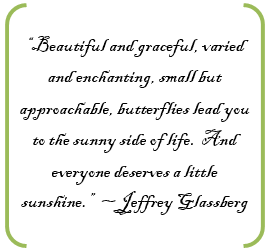 Butterflies are near-sighted. Planting flowers in groupings – 3 or more - will attract butterflies more than a single flower. Large sweeps of vivid color (purple, yellow, orange, pink and red) will be more alluring as will scented flowers. Butterflies rely on their sense of smell to help locate nectar flowers and have a highly developed sense of smell in their antennae. When selecting flowers for the garden, remember that the new hybrid flower varieties often have little nectar. Choose open-pollinated, fragrant, flowering plants. Extend the bloom season by pinching back the stems of annuals, in the early season, to create a fuller plant that has more blooms. Annuals and perennials often benefit from deadheading. Removing the spent flower stimulates the plant to produce more blooms for longer periods of time.
Butterflies are near-sighted. Planting flowers in groupings – 3 or more - will attract butterflies more than a single flower. Large sweeps of vivid color (purple, yellow, orange, pink and red) will be more alluring as will scented flowers. Butterflies rely on their sense of smell to help locate nectar flowers and have a highly developed sense of smell in their antennae. When selecting flowers for the garden, remember that the new hybrid flower varieties often have little nectar. Choose open-pollinated, fragrant, flowering plants. Extend the bloom season by pinching back the stems of annuals, in the early season, to create a fuller plant that has more blooms. Annuals and perennials often benefit from deadheading. Removing the spent flower stimulates the plant to produce more blooms for longer periods of time.Water: In addition to flowers, provide a water source near the nectar flowers by forming a puddle or shallow trench. To make a permanent puddle, bury a shallow container of wet gravel or wet sand. Add a few flat rocks for landing and keep the container filled with water.
Growing your own flowers from seed is a great way to bring in many different species that butterflies use as a nectar source. Some of the species are difficult to find, and growing from seed is just a fraction of the cost of nursery plants. In recent news, you may have heard of systemic pesticides that are used in many nurseries to produce a beautiful plant specimen that is sellable. If you want to make sure that you’re completely avoiding the possibility of pesticides, which could potentially kill the insects that you’re attracting, grow your own flowers for use in your butterfly garden. Following is a general collection, in no specific order, of 10 flowers that are rich in nectar and known for being attractive to butterflies. There is brief information on each flower, with tips on care and how to grow from flower seeds. The collection has both species that are native to the United States and not. Growing native species is always the best way to feed your local native butterflies. If you want to have an exclusively native garden, you would need to research your local area for native, nectar rich flowers.
Cosmos
 Cosmos are renowned for the profusion of blooms, from late spring until fall, and they are especially lovely when grown closely together to create a backdrop in the garden. These lovely flowers are also attractive to butterflies and beneficial insects, and the benefits of growing these flowers have only just begun!
Cosmos are renowned for the profusion of blooms, from late spring until fall, and they are especially lovely when grown closely together to create a backdrop in the garden. These lovely flowers are also attractive to butterflies and beneficial insects, and the benefits of growing these flowers have only just begun!Native to Mexico and South America, it is said that Cosmos were grown by Spanish priests in their mission gardens, and that they were the ones who named the flowers after the Greek word “kosmos” which means harmony or ordered universe. The evenly spaced and orderly petals inspired the name. Cosmos are said to symbolize balance and harmony.
Cosmos belongs to the vast family of plants known as Compositae. There are approximately 25 known species of Cosmos, but two annual species are the most familiar to the home gardener:
- Cosmos sulphureus – Sulphur Cosmos, Yellow Cosmos, Orange Cosmos, Klondike Cosmos. In this species, the blooms are always in shades of yellow, orange or red, and the leaves are long with narrow lobes and slightly hairy margins. The blooms can be 2 - 3 inches in width and daisy-like in appearance. Native species can reach 4 - 7 feet in height, but the cultivated varieties are not as tall, usually ranging from 1 - 3 feet.
- Cosmos bipinnatus – Garden Cosmos, Tall Cosmos, Mexican Aster, Cut Leaf Cosmos. This species has 2 - 3 inch white flowers or flowers in shades of lavender, pink and maroon. The leaves are finely cut, appearing almost thread-like, the foliage looks similar to ferns and has a very lacey appearance. Height can vary from 1 - 6 feet. There are many cultivated varieties offering different heights, colors, and variation in blooms such as double and picotee.
Rich, fertile soil is not needed for growing Cosmos but well-draining soil is. Excess fertilization of Cosmos will produce lots of foliage but few blooms. Water sparingly after seedlings emerge, but water deeply to make the plants more drought hardy. Cosmos will self-seed, but they are not considered to be aggressive. Deadhead the spent blooms to prolong the flower display. The plants can be cut back to 12 - 18 inches and will re-bloom in about 30 days. The stems can be somewhat weak, so staking may be required, as well as some protection from wind, especially for the taller cultivars.
Cosmos seeds grow under the worse conditions, yet they provide beautiful blooms that provide nectar for butterflies and make excellent cut flowers. It’s best to cut the flowers in the morning and then immediately place them in tepid water. Remove the foliage from the stems before arranging. Cosmos can also be preserved nicely.
Grow Cosmos in a location where they can receive lots of admiring glances; they make such a warm, colorful addition to any flower garden!
Echinacea
Echinacea will enhance any flower border or garden, and it’s lovely when grown in meadows and naturalized settings. The flowers are aromatic, daisy-like with slightly drooping petals, normally in shades of lavender and purple (although some cultivars are red, white and yellow) with an iridescent orange-red-brown, coned center. The name comes from the Greek word “echinos” which means hedgehog, and refers to the spiny cone. The flowers are arranged individually on long, sturdy stems, and the foliage is simple, lance-shaped and slightly rough. The bloom season is long, lasting much of the summer and into the fall. Echinacea is great for cutting with a long vase-life of 5 - 7 days.
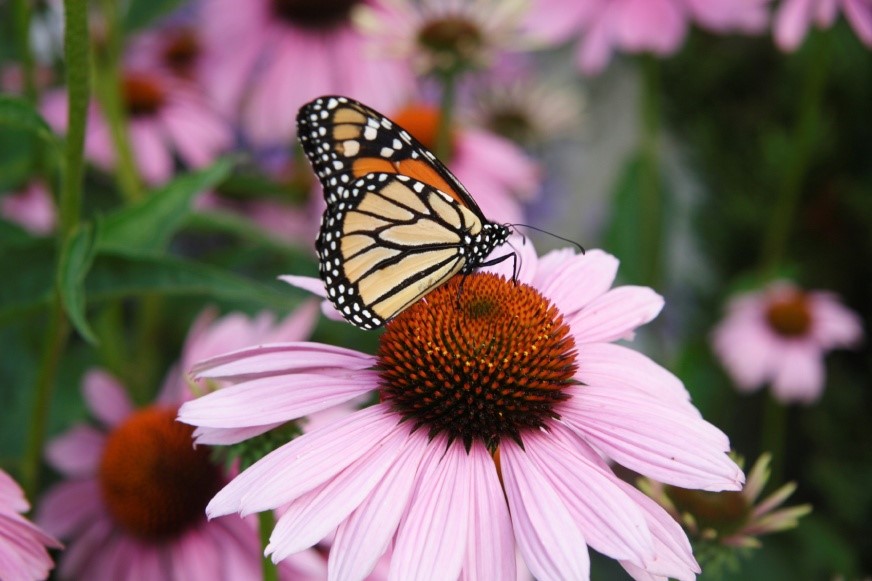 There are several species of Coneflower, and some of the more common are:
There are several species of Coneflower, and some of the more common are: Commercial growers recommend a pretreatment of cold/moist stratification for 30 - 90 days prior to planting Echinacea seeds in the spring after frost season has passed. In a prepared seedbed that is weed free, broadcast Echinacea seeds at a rate of 12 pounds per acre. Lightly rake the flower seeds into the soil, covering the seed with no more than 1/8 inch of soil. Keep the seeds moist, and with an optimal temperature of 70° - 75°F, germination is usually within 2 - 4 weeks. Propagation from root cuttings is also reliable when done in the fall.
Deadheading the spent flowers will promote additional blooms; however, leaving the flowers to dry will also attract songbirds in the winter. Echinacea plants should be divided every few years to keep them blooming well. Echinacea does not compete well with weeds, so weeds must be kept cut down, and mulching around the base of the plants with organic matter will help suppress weeds. Extra fertilizer is not needed if organic mulches are added each year to the base of the Echinacea clump.
Purple Coneflower was widely used by the American Indians as a remedy for illnesses and snake bites. Today, Echinacea is reported to improve the body’s immune system, and it’s used in treating respiratory illnesses, as an anti-inflammatory and in treating wounds. In commercial use, Echinacea roots are harvested after 3 - 4 years of growth as a medicinal herb, although the entire plant can be dried and used in teas.
Echinacea is a marvelous perennial to add to your landscape! Not only do butterflies love to sip the rich nectar, but it’s a hardy flower that does not demand tremendous care in order for it to perform its best.
Agastache
There are several well-known Agastache varieties:
- Agastache foeniclum – known as Anise Hyssop or Giant Blue Hyssop, this variety has a definite licorice aroma and blue to purple flowers. The leaves are used for flavoring or teas and were widely used as a medicinal herb by the Native Americans.
- Agastache Mexicana – referred to as Mexican Giant Hyssop; it is native to southern North America and Mexico. The leaves are also used for teas and in salads.
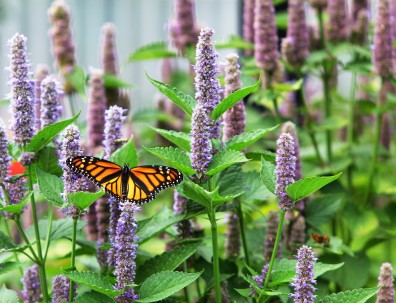 Agastache cana – called Hummingbird Mint, Mosquito Plant, and Bubblegum Mint. It has a distinctive bubblegum scent with rosy-pink colored flowers.
Agastache cana – called Hummingbird Mint, Mosquito Plant, and Bubblegum Mint. It has a distinctive bubblegum scent with rosy-pink colored flowers.
Agastache is an easy, undemanding perennial to grow, preferring sun but tolerating some light shade. It dislikes waterlogged soil, so drainage is very important for a good performance. Provide a complete organic fertilizer each spring. Mature plants require a moderate amount of moisture and can dry out in-between waterings. If growing as an herb, harvest fresh leaves just before blooming for best flavor. If needed, the plants can be divided in the fall. Division will help keep the plant robust and healthy. In areas with very cold winters, a heavy mulch gives extra protection. When different varieties are grown together, cross pollination may occur. Deadheading the spent blooms and removing any volunteers will help prevent cross pollination.
These striking and versatile flowers are also great for cutting. They have lengthy stalks and last well in the vase. Agastache will win your heart, and because it’s a known nectar plant, you’ll also win the adoration of many buzzing and delightful insects who will call your garden home!
Pentas
 There are a few common names for the flower (starflower, Egyptian star flower, Egyptian star clusters, and Egyptian stars), but they are used more outside of the United States. Pentas is both a descriptive name and the Greek word for “five.” The dense clusters are made of long-tubed, star-shaped flowers, and each flower has five floral petals. The clusters can reach 3 - 4 inches across, and their colors are in vivid shades of white, pink, red, and lavender. Some are two-toned and all are extremely attractive to butterflies, and the red and dark pink varieties are loved by the hummingbirds. The contrasting dark green leaves are lance-shaped, 3 inches long and deeply veined. The attractive foliage provides the perfect back-drop for the prolific clusters of flowers.
There are a few common names for the flower (starflower, Egyptian star flower, Egyptian star clusters, and Egyptian stars), but they are used more outside of the United States. Pentas is both a descriptive name and the Greek word for “five.” The dense clusters are made of long-tubed, star-shaped flowers, and each flower has five floral petals. The clusters can reach 3 - 4 inches across, and their colors are in vivid shades of white, pink, red, and lavender. Some are two-toned and all are extremely attractive to butterflies, and the red and dark pink varieties are loved by the hummingbirds. The contrasting dark green leaves are lance-shaped, 3 inches long and deeply veined. The attractive foliage provides the perfect back-drop for the prolific clusters of flowers. Pentas are very well suited to containers, planters, and hanging baskets. For large garden beds, Pentas are beautiful in mass plantings. They perform best in fertile, well-drained soils with regular moisture. They will flower in full sun and in light shade. Less than 6 hours of sun will reduce flowering. Prepare a bed by adding 3 - 4 inches of organic matter and tilling it into the soil. A soil pH of 7 is preferred, so in acidic soil, add lime into the soil before tilling. Once the plants are established, they are fairly drought and heat tolerant. Pentas have a fast growth rate, and their growth habit creates a rounded, dense plant. In their native habitat, Pentas grow 3 - 6 feet in height, but in non-tropical climates, they can reach 24 - 30 inches in height and about the same in width. There are also dwarf varieties that only reach 12 inches in height and are well-suited to containers.
When grown as a perennial, Pentas will bloom throughout most of the year. Each winter, prune plants back to encourage a compact, bushy growth habit. In USDA zone 8, apply heavy mulch over the plants after they have been cut back to the ground to help them over winter. In colder zones, Pentas can be dug, cut back and stored in soil. While storing, water the plants occasionally to keep the roots from drying out and then re-plant in the spring once danger of frosts have passed and fertilize. To help Pentas have a bountiful supply of blooms, fertilize regularly throughout the growing season and remove the spent flower clusters. The dwarf varieties are also grown as house plants in bright, sunny windows.
Propagation is by cuttings or from flower seeds. Start the Pentas seed indoors in late winter. The seeds are tiny, so do not cover them with soil as they require light for germination. When grown from flower seed, about 14 weeks are required to produce a blooming plant, and a good light source is needed for proper growth. Pinch back the early growth in order to encourage bushier plants.
Gardeners have said that butterflies will visit Pentas before any other flowers, and that butterflies can be seen circling the flower clusters waiting for their turn to enjoy the rich nectar. Pentas offer a profusion of color, wonderful nectar for butterflies and hummingbirds, and they require so little maintenance. In addition … it may be difficult to bring yourself to cut some of these gorgeous flowers, but they are excellent for cutting and do well in the vase. Wow, what an amazing flower to add to your summer landscape!
Salvia
Salvias provide a wonderful source of both nectar and pollen. The upright flower spikes contain numerous blossoms that stay open for an extended amount of time, and their attraction is obvious as the hummingbirds, butterflies and bees become frequent visitors. Salvias are excellent for large flower beds where they can be planted in a mass grouping. The smaller varieties are also very nice for containers.
There are over 900 Salvia species known around the world, and their habitat varies from deserts, rocky mountainous regions, to moderately moist areas. Typically, Salvias like full sun, but tolerate light shade, and they prefer moist, well-drained soil. There is a wide variety in forms, textured foliage, and brightly colored flower spikes. The colors can be in shades of reds, pinks, white, violets and blues. Depending on the species, they can be annuals, biennials, perennials or shrubs. Some of the Salvia species include:
- Salvia officinalis – Kitchen sage
- Salvia sclarea – Clary Sage
- Salvia azurea – Blue Sage, hardy to zone 5,
- Salvia coccinea – Texas Hummingbird Sage or Scarlet Sage
- Salvia splendens – Pineapple Sage
- Salvia horminum – Annual Clary
- Salvia farinacea – Mealy-cup Sage
- Salvia leucantha - Mexican Bush Sage
 Even though Salvias are very attractive, they also repel deer and rabbits. Many types are also suitable for xeriscaping, and there are no diseases or insects pests that are problematic. They require very little work, and they provide color in the garden from late spring through early fall. They are also quite lovely when cut and added to fresh arrangements. Some species, such as Salvia farinacea, preserve well. To dry, cut the flowers before the top fourth of the flowers are open; tie several stems together and hang them up-side-down in a dark well-ventilated place.
Even though Salvias are very attractive, they also repel deer and rabbits. Many types are also suitable for xeriscaping, and there are no diseases or insects pests that are problematic. They require very little work, and they provide color in the garden from late spring through early fall. They are also quite lovely when cut and added to fresh arrangements. Some species, such as Salvia farinacea, preserve well. To dry, cut the flowers before the top fourth of the flowers are open; tie several stems together and hang them up-side-down in a dark well-ventilated place.Salvias are propagated by cuttings or flower seeds. The Salvia seeds can be started indoors 10 - 12 weeks before the last frost is expected. The seeds need light for germination, so press the flower seeds into the soil but do not cover them. Wait to plant annual and semi-hardy species until after all danger of frost is past. Salvias are known to re-seed but are non-aggressive and non-invasive. Deadheading can be done to encourage more blooming and to prevent self-sowing. Because Salvias are heavy blooming, they benefit from some fertilizer. Fertilize the plants once a month with a balanced water-soluble fertilizer, or add a slow-release fertilizer at the time of planting. For the perennial species, wait until new growth begins to show in the spring before cutting back the old stems. Perennial Salvias can be divided in the early spring before new growth begins.
For a neat, attractive, low-maintenance plant that brings long-lasting beauty to your garden, nectar and pollen to the butterflies, grow a Salvia plant or two! The choices are many, but it’s guaranteed to be a charming addition to your beds and borders, and you’ll also have a few new winged friends who admire the flowers too.
Achillea
With a large variation in sizes - from a dwarf, creeping ground cover to a tall, nearly 4 foot tall plant - there is likely to be just the right placement for Yarrow in your landscape. The flowers are in shades of white, red, pink, and yellow, and they typically bloom from late spring through fall. The clustered, flat-topped flowers packed in a composite head allow the butterfly to use its long tongue to drink nectar from deep within the flower. Yarrow foliage has a spicy aroma with colors varying from dark green to gray green. The foliage is fine, feathery and covered with soft wooly hairs.
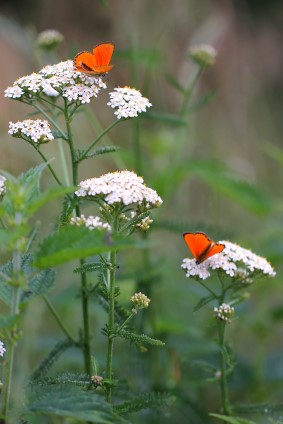 This perennial herb has a long history of medicinal use. Legend says that is was named after the Greek mythical hero, Achilles, who gave it to his men to apply to battle wounds. There have been few scientific studies done on the effectiveness of the herb, but it has been traditionally used for centuries to treat minor wounds and bleeding. It has also been taken by mouth to reduce inflammation, and to relieve anxiety and insomnia. Native Americans made tea from the leaves to treat headaches, toothaches and colds. During the Civil War, the medicinal herb was widely used to treat the soldiers’ wounds, and it was then named “Soldier’s Woundwort.”
This perennial herb has a long history of medicinal use. Legend says that is was named after the Greek mythical hero, Achilles, who gave it to his men to apply to battle wounds. There have been few scientific studies done on the effectiveness of the herb, but it has been traditionally used for centuries to treat minor wounds and bleeding. It has also been taken by mouth to reduce inflammation, and to relieve anxiety and insomnia. Native Americans made tea from the leaves to treat headaches, toothaches and colds. During the Civil War, the medicinal herb was widely used to treat the soldiers’ wounds, and it was then named “Soldier’s Woundwort.”A member of the aster family, Yarrow is closely related to chrysanthemums and chamomile, and the aromatic foliage resembles the scent of chamomile. It is fairly deer resistant and flourishes in meadows and along roadsides. It can spread by both seeds and rhizomes. The spreading nature of Achillea plants allows it to be used as a ground cover.
A few of the more common varieties are: Propagation of Yarrow includes both flower seeds and division of plants. Yarrow seeds can be started indoors in the late winter or early spring. Achillea seeds germinate best if they are gently pressed into the pre-moistened soil, but they should not be covered. Direct seeding can be done in late spring, early summer or fall, when soil temperatures are 60 - 65°F. Flower seeds and seedlings require consistent moisture. When grown from seeds, Yarrow requires 2 years for blooming.
Yarrow adapts to a wide variety of soils, but it prefers sandy or gravelly loam. A position in full sun is best, but it will tolerate light shade. Achillea Yarrow is fairly drought tolerant; however, avoid over watering and excessive fertilization as the plants can become leggy. A spring division is recommended every 2 - 3 years to maintain a vigorous plant. The taller Achillea plants can require some staking. Spent flower clusters can be removed as they fade to prolong the bloom time.
Don’t be fooled by the delicate beauty of Yarrow. It’s a tough perennial that handles some neglect, yet it will provide a wonderful source of nectar for butterflies and other beneficial insects. The blooms are also great for cutting, so it’s truly a win-win flower for every landscape!
Rudbeckia
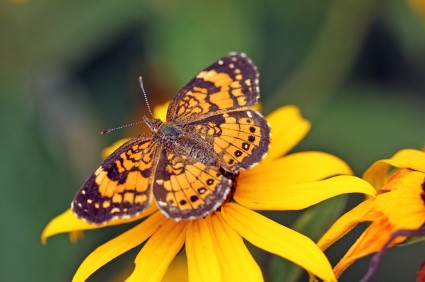 There are about 30 Rudbeckia species that can be annual, biennial or perennial. There are countless varieties and cultivars that have been introduced and different forms of Rudbeckia can be found naturalized across the United States. Some of the species include:
Rudbeckia hirta was named after the Swedish father and son professors of botany, O.J. Rudbeck (1630 - 1702) and O.O. Rudbeck (1660 - 1740). The additional hirta means “rough” as the plant has course hairs on the stems and on the lance-shaped leaves. It is commonly called Black Eyed Susan, and it grows in meadows, prairies and along roadsides in sandy, loamy or even clay soils. The flowers are 2 - 3 inches across or more and in colors of yellow, orange, orange-red and bi-color with a large brownish-black domed center. The petals may be single or double. The stems are strong and are excellent for cutting often lasting in a vase for 6 - 10 days.
There are about 30 Rudbeckia species that can be annual, biennial or perennial. There are countless varieties and cultivars that have been introduced and different forms of Rudbeckia can be found naturalized across the United States. Some of the species include:
Rudbeckia hirta was named after the Swedish father and son professors of botany, O.J. Rudbeck (1630 - 1702) and O.O. Rudbeck (1660 - 1740). The additional hirta means “rough” as the plant has course hairs on the stems and on the lance-shaped leaves. It is commonly called Black Eyed Susan, and it grows in meadows, prairies and along roadsides in sandy, loamy or even clay soils. The flowers are 2 - 3 inches across or more and in colors of yellow, orange, orange-red and bi-color with a large brownish-black domed center. The petals may be single or double. The stems are strong and are excellent for cutting often lasting in a vase for 6 - 10 days.Rudbeckia plays an important role in nature, and they are considered to be the most widely known wildflower. Black-eyed Susans are very competitive and they can push other plants out of an area. They are also considered to be a pioneer plant, meaning that they are one of the first to grow on land that has been destroyed by fire. Medicinally, Rudbeckia root was made into tea to treat worms and colds. The root was also used to make a topical wash to treat wounds and snakebites. It is said to have immune-stimulant activity similar to Echinacea.
Rudbeckia is propagated by division, cuttings and flower seeds. The Black-eyed Susan seeds can be started indoors or directly outside and are known for producing flowers in about 14 weeks after seeding. For indoor seeding, start the flower seeds 6 - 8 weeks before the last expected frost. Rudbeckia seeds should not be covered but pressed into the soil for good contact; the flower seeds need light for germination. The plants reach 2 - 3 feet tall and form a clump that’s 2 - 3 feet wide. Once established, Rudbeckia is very forgiving of neglect and can bloom from mid-summer until frost.
Grow Rudbeckia in full sun and well-drained, moist soil. They have a moderate drought tolerance. Deadheading the spent flowers will encourage continued blooming, but if a few flowers are left to go to seed, Black-eyed Susans will remain year after year by re-seeding. It’s recommended to water at the roots instead of overhead to help avoid fungal disease, but in general, the plants are very resistant to both disease and pests.
Rudbeckia flowers are versatile, offering a beautiful color display whether planted alone, in a container, in a mass, along a border, or along a fence line. They are ideal for attracting bees and butterflies, and if they are left to dry, the ripe cone heads provide seeds to hungry birds in late fall and winter.
Eupatorium
- Eupatorium perfoliatum - known as Common Boneset, and
- Eupatorium maculatum - known as Joe Pye Weed
 Eupatorium perfoliatum can reach up to 5 feet tall, and it blooms from July through October. The flower heads are large and flat and are made of ¼ inch white flowers. The flowers are showy, long-lived and very attractive to wildlife. The leaves have a wrinkled texture, and they grow on opposite sides of the stem, but they are joined at the base, encircling the stem. It appears that the stem is growing through the leaf, so to ancient herbalists, this indicated that the plant would be useful in setting bones. The Boneset leaves were wrapped with bandages around splints to heal broken bones.
Eupatorium perfoliatum can reach up to 5 feet tall, and it blooms from July through October. The flower heads are large and flat and are made of ¼ inch white flowers. The flowers are showy, long-lived and very attractive to wildlife. The leaves have a wrinkled texture, and they grow on opposite sides of the stem, but they are joined at the base, encircling the stem. It appears that the stem is growing through the leaf, so to ancient herbalists, this indicated that the plant would be useful in setting bones. The Boneset leaves were wrapped with bandages around splints to heal broken bones.Joe Pye Weed is tall - up to 6 feet - and bushy with stems that are spotted or evenly purplish. The leaves are sharply toothed and form in whorls of 4 - 5. The flat-topped, branched cluster of flowers is in shades of pink to purple and is lightly scented. Bloom time is July through September and the flowers are very showy especially when planted in mass plantings.
Other common names for Eupatorium maculatum are: Spotted Joe Pye Weed, Purple Boneset, and Spotted Trumpet Weed. This Eupatorium also has medicinal benefits. The legend behind Eupatorium maculatum is that an American Indian, Joe Pye, used this plant to cure fevers and treated American colonists during an outbreak of typhus.
Eupatorium is attractive to birds, butterflies and bees, with E. maculatum being the favorite of butterflies. It provides nectar for butterflies such as the Giant Swallowtail, Tiger Swallowtail and the Orange Sulphur. Sadly, it is more and more difficult to find Eupatorium in the wild, but nurseries that carry native plants will often have it available for purchase.
In general, Eupatorium prefers a specific growing environment such as full sun to partial shade, wet ground, on the edges of swamps, along streams, or in meadows and marshlands, and it prefers sandy, loamy or limy soil.
Propagation of Eupatorium is either through plant division or flower seeds. Eupatorium seeds can be started in either late fall (dormant planting) or early spring. Spread the wildflower seeds over a prepared seedbed that is weed free and tamp the seeds in, covering with no more than 1/8 inch of soil. Keep the seedbed moist. Pinch back the young Eupatorium seedlings to promote shorter, bushier plants that are not as vulnerable to the wind. Once grown, apply a balanced liquid fertilizer when the flower heads appear and apply every other week until flowering is done. Eupatorium plants can be divided in spring or fall.
Whether you chose to have Eupatorium stand alone, in a mass planting, or select one or two plants for the back of the flower border, this attractive perennial will give a wonderful, long-lasting display and will be attractive to beneficial insects. In addition … you have some great folklore to share with your neighbors on the history of these plants!
Aster (photo of Aster on front cover)
Some of the species include:
- Aster thomsonii – Himilayan Aster
- Aster amellus – Italian Aster
- Aster novi-angliae – New England Aster
- Aster alpinus – Alpine Aster
- Aster tongolensis – East Indies Aster
- Aster novi-belgii – New York Aster
Asters grow best in full sun to partial shade, and they need well-drained soil, a moderate amount of water, and good air circulation. Powdery mildew is a common disease, so it’s also suggested to water at the base of the plant instead of overhead and to allow for plenty of space between plants. Division is needed every 3 years to help keep the plant vigorous. In early spring, once new growth is evident, divide the plant. The outer portions of the plant can be re-planted, and the spent inner portion should be discarded. Some species may reseed, so deadheading is helpful to remove the spent flowers before they go to seed.
Propagation is by division, cuttings or flower seeds. Aster seeds started indoors will germinate in approximately 15 days and when started outdoors, germination will take 20 - 30 days. The seed should be covered lightly with soil, 1/16 of an inch. When grown from flower seed, pinching the young plants encourages a bushier growth habit.
The various species range in size from 8 inches to 5 feet. The taller varieties may need some staking to keep from flopping over, but they also do well with a good pruning by mid-June. It’s suggested to cut the plant back by one-half. Cut outer stems shorter than the center stems to create a nicely rounded shape. It may seem severe, but cutting it back and shaping it encourages the flowers to form closer to the base and eliminates ugly brown stems. The blooming is only delayed by a few days, and a much prettier plant is produced.
A well-cared for Aster can bring a display of fireworks to the fall garden scene. You’ll be happy for the late season color, and the butterflies will be happy for the food source!
Monarda
Monarda is native to North America. It is in the mint family and common names include Bee Balm, Oswego Tea, Wild Bergamot, Horsemint and several more. The plant has a clumping, upright growth habit, square stems, and it spreads by underground rhizomes. The tubular flowers are typically shades of red, purple, pink and white, and resemble small fireworks. They are late blooming, adding lots of color to the garden when other flowers have finished.
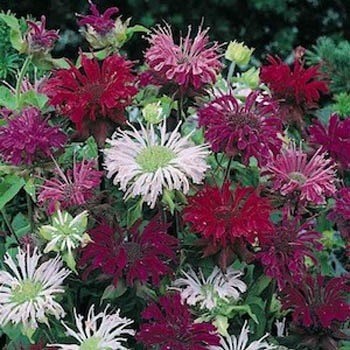 The early American settlers found that the dried Monarda leaves made a good tea, naming the plant Oswego tea as the plant grew along the Oswego River. After the Boston Tea Party, Oswego tea was used instead of the British black tea. Long before the Europeans came to America, the Native American tribes were using Bee Balm as a cold remedy and an antiseptic. Even today, the essential oil is being scientifically researched for its benefits in treating wounds and prevention against infections.
The early American settlers found that the dried Monarda leaves made a good tea, naming the plant Oswego tea as the plant grew along the Oswego River. After the Boston Tea Party, Oswego tea was used instead of the British black tea. Long before the Europeans came to America, the Native American tribes were using Bee Balm as a cold remedy and an antiseptic. Even today, the essential oil is being scientifically researched for its benefits in treating wounds and prevention against infections.Species include:
- Monarda didyma – Oswego Tea
- Monarda fistulosa – Wild Bergamot
- Monarda punctata – Horse Mint
- Monarda citriodora – Lemon Bee Balm
Monard propagation is through flower seeds, cuttings or root divisions. The Bee Balm seeds can be started indoors in the late winter for transplanting outside. Or the Monarda seeds can be started directly outside in a weed free seed bed that has been cultivated and raked to a fine tilth. Cover the flower seeds thinly with soil, no more than the thickness of the seed. The seeds can be sown outdoors in the early spring before the frost season has ended and in the fall allowing 8 weeks before frost season to begin. When grown from flower seeds, Monarda will not have blooms until the 2nd or possibly even the 3rd year.
In addition to inviting bees, butterflies and hummingbirds to the garden, Bee Balm is a great flower for cutting, and the foliage is wonderfully aromatic and has a minty scent. Monarda is long flowering, and dead heading the spent blooms encourages more flowers. Both the flowers and leaves can be dried and used in potpourri and sachets. For drying, cut the flowers just before they open. Because of the plant’s height, place the plant in the middle or toward the back of the flower border. But always make sure that Bee Balm is in clear view from the window so that you can enjoy watching the wildlife that comes to visit!
Bonus Flower – Asclepias!
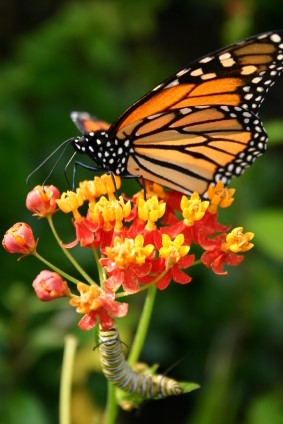 One particular flower that is an invaluable food source for Monarch butterflies is Milkweed. It is scientifically known as Asclepias, and there are many varieties that are native to North America. The common name really does a disservice to this incredible plant. Without the Milkweed, the Monarch butterfly cannot exist. This native wildflower is a host and nectar plant – the adult Monarch butterfly lays its eggs on the Asclepias plant, and as the caterpillars emerge, they eat the leaves of the plant. Even more fascinating is the fact that Asclepias are poisonous, but instead of the toxin killing the hungry caterpillar, the caterpillar becomes poisonous itself. Even as an adult butterfly, the Monarch is poisonous to its would-be predators, which wisely leave it alone. Monarch butterflies cannot exist without Milkweed plants, but tragically colonies of these wildflowers are being destroyed as buildings and developments go up. The good news is that every home garden can grow these important and attractive flowers!
One particular flower that is an invaluable food source for Monarch butterflies is Milkweed. It is scientifically known as Asclepias, and there are many varieties that are native to North America. The common name really does a disservice to this incredible plant. Without the Milkweed, the Monarch butterfly cannot exist. This native wildflower is a host and nectar plant – the adult Monarch butterfly lays its eggs on the Asclepias plant, and as the caterpillars emerge, they eat the leaves of the plant. Even more fascinating is the fact that Asclepias are poisonous, but instead of the toxin killing the hungry caterpillar, the caterpillar becomes poisonous itself. Even as an adult butterfly, the Monarch is poisonous to its would-be predators, which wisely leave it alone. Monarch butterflies cannot exist without Milkweed plants, but tragically colonies of these wildflowers are being destroyed as buildings and developments go up. The good news is that every home garden can grow these important and attractive flowers!
Some of the more familiar Milkweeds and their common names: There is little care in growing Milkweed, however finding the plants can be more challenging. The plants are not commercially available, but nurseries specializing in native plants will often have Asclepias, and they can readily be grown from Milkweed seeds. Common Milkweed is one that may be difficult to contain because it spreads easily by both seeds and rhizomes, so in the home garden, the other varieties that are less aggressive are usually preferred. Monarch butterfly experts report that Asclepias curassavica is the most preferred by the butterflies. It’s a tender perennial that is often grown as an annual. In general, Milkweed plants prefer a well-drained, sunny location. They do not require additional fertilizers. Deadheading can extend the bloom time for some varieties.
Milkweed can be propagated by stem cuttings or flower seeds. Asclepias seeds germinate better with a cool, damp stratification. A suggested method is to place the flower seeds in a bag or container of moistened peat moss, and then place it in the refrigerator for 6 - 10 weeks or more. The seeds can be then directly seeded outside in warm soil or started indoors in trays. The flower seed and seedlings will need regular attention and moisture; however, the mature plants will tolerant some drought. The mature Asclepias forms a long tap root, so where they are planted, they should be left, and division of the plants is not recommended. When grown from flower seeds, Milkweed will bloom the second year of growth. Bloodflower seeds do not require stratification, and they do not form the long tap root that the other varieties have.
Asclepias have been used as a medicinal herb for centuries. In fact, the genus was named after the Greek god of medicine. The plants contain cardiac glycosides which increase the force of heart contractions, and also have a potential anti-cancer application. The plants are potentially toxic to livestock and humans, but large quantities are required to be consumed before poisoning. Many insects and hummingbirds will eat the nectar and pollen from the flowers, but the flowers do not contain the glycosides.
When growing Milkweed in your garden, it’s suggested to plant them in groupings. Butterflies are more likely to notice a group of the plants, and the females will seek them out for egg laying. It’s important to avoid chemical insecticides on Asclepias, as they may kill the Monarch eggs and larvae. Milkweed is not only lovely to grow, but you can have such satisfaction knowing that you’re providing for a butterfly species that depends on this amazing plant!
 Gardening and attracting wildlife seem to go hand-in-hand. We delight in attracting and providing food for beautiful creatures, and none are more beautiful than butterflies. This list of nectar-rich flowers for butterflies is only the beginning of many different trees, shrubs, herbs and ornamentals that provide a good source of food for the adult insects. With some more research for your particular area, you can select plant species that give a spring through fall supply of nectar. Creating a butterfly garden is a skill that requires some research and study. For the best success, learn more about butterflies in your area, learn how to identify both the caterpillars and the adults, learn about the food sources, and where they live. Collect some good resources for study, and as with any new skill, time and experience will allow you to reap the rewards of having many lovely butterflies flutter by.
Gardening and attracting wildlife seem to go hand-in-hand. We delight in attracting and providing food for beautiful creatures, and none are more beautiful than butterflies. This list of nectar-rich flowers for butterflies is only the beginning of many different trees, shrubs, herbs and ornamentals that provide a good source of food for the adult insects. With some more research for your particular area, you can select plant species that give a spring through fall supply of nectar. Creating a butterfly garden is a skill that requires some research and study. For the best success, learn more about butterflies in your area, learn how to identify both the caterpillars and the adults, learn about the food sources, and where they live. Collect some good resources for study, and as with any new skill, time and experience will allow you to reap the rewards of having many lovely butterflies flutter by.Resources used:
http://umaine.edu/publications/7151e/
http://www.aces.edu/pubs/docs/A/ANR-1290/ANR-1290.pdf
http://easttexasgardening.tamu.edu/tips/misc/butterfly.html
http://watauga.ces.ncsu.edu/files/library/95/Bfly%20Gardening%20factsheet.pdf
http://apps.caes.uga.edu/urbanag/home&garden/indexFS.cfm?storyid=2561
Cosmos
http://aggie-horticulture.tamu.edu/archives/parsons./flowers/cosmos/cosmos.html
http://www.gardening.cornell.edu/homegardening/scene4d85.html
http://ucjeps.berkeley.edu/cgi-bin/get_JM_treatment.pl?609,1020,1022
http://www.gardening.cornell.edu/homegardening/scene9a85.html
http://extension.usu.edu/files/publications/publication/Horticulture_Vegetables_2013-01c.pdf
http://www.public.asu.edu/~camartin/plants/Plant%20html%20files/cosmosbipinnatus.html
Echinacea
http://natsci.edgewood.edu/wingra/management/raingardens/Echinacea/How%20to%20Grow%20Page.htm
http://www.uky.edu/Ag/NewCrops/introsheets/echinacea.pdf
Agastache
http://ucanr.edu/sites/scmg/Plant_of_the_Month/Agastache/
http://www.ag.ndsu.edu/archive/dickinso/research/2000/Cultivar/1.htm
http://www.ces.ncsu.edu/depts/hort/consumer/factsheets/herbs/agastache_foeniculum.html
http://wisplants.uwsp.edu/scripts/detail.asp?spcode=AGAFOE
http://greenhouse.kenyon.edu/greenhouseplants/Agastache%20foeniculum.htm
http://www.gardeningknowhow.com/edible/herbs/hyssop/growing-agastache.htm
Pentas
http://www.gardeningsolutions.ifas.ufl.edu/giam/plants_and_grasses/flowering_plants/pentas.html
http://www.arhomeandgarden.org/plantoftheweek/articles/Butterfly_Pentas.htm
http://msucares.com/news/print/sgnews/sg05/sg050512.html
http://florawww.eeb.uconn.edu/198500651.html
http://pss.uvm.edu/pss123/tppentas.htm
http://bygl.osu.edu/content/annual-pentas-star-cluster-or-egyptian-star-flower-pentas-lanceolata-0
http://www.indstate.edu/facilities/grounds/pentas.htm
http://www.extension.iastate.edu/newsrel/2004/mar04/mar0403.html
Salvia
http://www.ext.colostate.edu/pubs/columngw/gr110611.html
http://www.extension.iastate.edu/newsrel/2003/jul03/jul0321.html
http://www.gardening.cornell.edu/homegardening/scene81de.html
http://www.gardening.cornell.edu/homegardening/scene4695.html
http://www.clemson.edu/extension/hgic/plants/landscape/flowers/hgic1174.html
http://www.gardening.cornell.edu/homegardening/scenedbe3.html
http://www.ipm.ucdavis.edu/PMG/GARDEN/PLANTS/salvia.html
http://hendry.ifas.ufl.edu/HCHortNews_Salvias.htm
Yarrow
http://umm.edu/health/medical/altmed/herb/yarrow
http://www.turf.uiuc.edu/weed_web/descriptions/commonyarrow.htm
http://www.oardc.ohio-state.edu/weedguide/singlerecord.asp?id=1090
http://extension.psu.edu/plants/gardening/herbs/common-yarrow
http://baker.ifas.ufl.edu/Horticulture/Yarrow.html
http://www.ces.ncsu.edu/depts/hort/consumer/factsheets/groundcover/achillea_tomentosa.html
http://www.gardening.cornell.edu/homegardening/scene90fb.html
http://www.ksre.ksu.edu/bookstore/pubs/mf1069.pdf
Rudbeckia
http://www.fcps.edu/islandcreekes/ecology/black-eyed_susan.htm
http://wisplants.uwsp.edu/scripts/detail.asp?SpCode=RUDHIRvPUL
http://www.ces.ncsu.edu/depts/hort/consumer/factsheets/annuals/rudbeckia_hirta.html
http://www.bio.brandeis.edu/fieldbio/medicinal_plants/pages/Black_Eyed_Susan.htm
http://www.bio.brandeis.edu/fieldbio/Survival_Gold_Uygur/Pages/Black-EyedSusan.html
http://www.ext.colostate.edu/pubs/columngw/gr120616.html
http://blog.lib.umn.edu/efans/ygnews/2011/09/black-leaves-on-black-eyed-sus.html
http://aggie-horticulture.tamu.edu/wildseed/20/20.2.html
http://aggie-horticulture.tamu.edu/wildseed/gloriosadaisy.html
http://www.gardening.cornell.edu/homegardening/scene701e.html
Eupatorium
http://mason.gmu.edu/~hphamb/project/plant/plant.htm
http://www.plantoftheweek.org/week223.shtml
http://wisplants.uwsp.edu/scripts/detail.asp?SpCode=EUPMAC1
http://nativeplants.evergreen.ca/search/view-plant.php?ID=00298
http://www.clemson.edu/extension/hgic/plants/indoor/flowering/hgic1559.html
Aster
http://www.gardening.cornell.edu/homegardening/scenef99f.html
http://www.gardening.cornell.edu/homegardening/scened928.html
http://www.gardening.cornell.edu/homegardening/scene912b.html
http://www.colostate.edu/Depts/CoopExt/4DMG/Flowers/Perenls/asters.htm
http://extension.psu.edu/pests/plant-diseases/all-fact-sheets/aster-diseases
http://web.extension.illinois.edu/cfiv/homeowners/060427.html
http://pss.uvm.edu/pss123/peraster.html
http://www.uky.edu/Ag/Horticulture/gardenflowers/asters.pdf
http://pss.uvm.edu/ppp/articles/asters2.html
Monarda
http://www.uvm.edu/~pass/perry/cohmild.html
http://pss.uvm.edu/pss123/permonar.html
http://pharmacology.georgetown.edu/urbanherbs/bee_balm.htm
http://expert.hort.iastate.edu/faq/view/id/387
http://urbanext.illinois.edu/hortanswers/plantdetail.cfm?PlantID=735&PlantTypeID=2
http://www.frostburg.edu/aces/kids-page/monarda-didyma/
http://www.hort.purdue.edu/newcrop/med-aro/factsheets/bergamot.html
http://talon.niagara.edu/~mgallo/organisms/Monarda.html
http://www.ksre.ksu.edu/ksherbs/bee_balm.htm
Asclepias
http://edis.ifas.ufl.edu/fp049
http://edis.ifas.ufl.edu/fp050
http://aggie-horticulture.tamu.edu/wildseed/21/21.4.html
http://www.clemson.edu/cafls/demo/plant_profiles/asclepias_tuberosa.html
http://www.ces.ncsu.edu/depts/hort/consumer/poison/Ascletu.htm
http://urbanext.illinois.edu/hortanswers/plantdetail.cfm?PlantID=708&PlantTypeID=2
http://urbanext.illinois.edu/hortanswers/plantdetail.cfm?PlantID=811&PlantTypeID=14
http://wisplants.uwsp.edu/scripts/detail.asp?Spcode=ASCINCsINC
http://www.ces.ncsu.edu/depts/hort/consumer/factsheets/wildflowers/asclepias_incarnata.html
http://www.usi.edu/science/biology/twinswamps/Asclepias_incarnata.htm
http://www.fcps.edu/islandcreekes/ecology/common_milkweed.htm
http://agron-www.agron.iastate.edu/~weeds/weedbiollibrary/u4milkw1.html
http://www.botany.hawaii.edu/faculty/carr/asclepiad.htm
http://www.ces.ncsu.edu/depts/hort/consumer/factsheets/annuals/bloodflower.html
http://nativeplants.ku.edu/research/asclepias-research/asclepias-milkweeds
http://aggie-horticulture.tamu.edu/archives/parsons/flowers/butterfl.html
http://www.oardc.ohio-state.edu/weedguide/singlerecord.asp?id=580
































